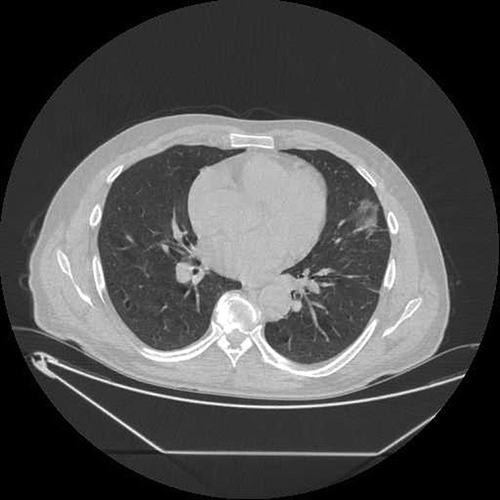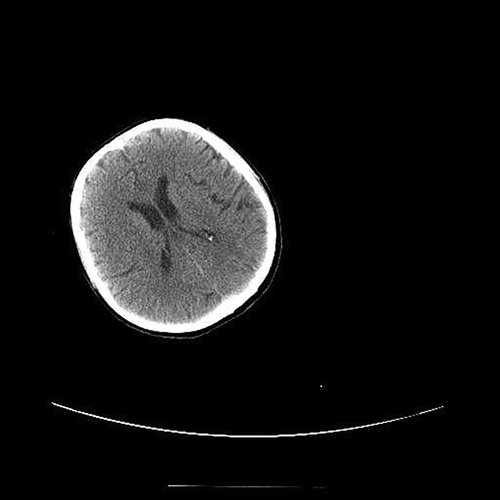Abstract
The central nervous system (CNS) toxicity of fluoroquinolones is well known but usually occurs benign. In the literature, there are a few number of severe CNS toxicity cases related to fluoroquinolones. Levofloxacin is a third-generation fluorinated quinolone antibiotic, is the active levo stereoisomer of ofloxacin, and has one of the most favorable adverse reaction profiles. We describe a case of delirium associated with levofloxacin in a 55-year-old man who was hospitalized in our medical clinic for pneumonia.
INTRODUCTION
Fluoroquinolones are a class of antibacterial agents for the treatment of several infectious diseases. They are commonly used around the world for their large spectrum of activity, high bioavailability, and good safety profile. Their widely known mechanism is the inhibition of the DNA gyrase enzyme. In addition, they inhibit gamma-aminobutyric acid (GABA) which is a well-known inhibitory neurotransmitter.Citation1
The most known adverse events are gastrointestinal tract reactions (3–17%), central nervous system (CNS) reactions (0.9–11%), and dermatological reactions (0.5–3%).Citation2 Nephrotoxicity, tendinitis, arthropathy, and cardiovascular tonification are seen infrequently.Citation3 CNS symptoms include headache, dizziness, drowsiness, abnormal vision, sleep disorders, agitation, acute organic psychosis, confusion, and delirium.Citation4,5
Drug-induced delirium is a well-known entity with sedatives, narcotics, and anticholinergics.Citation6,7 Delirium related to antibiotics, mainly cephalosporins, macrolides, and other fluoroquinolones,Citation8–10 has been infrequently reported, but only a few cases of levofloxacin-induced delirium have been previously published.Citation11–14
We described another case of delirium associated with levofloxacin in a 55-year-old male patient who was hospitalized in our medical clinic for acute renal failure and pneumonia.
CASE
A 55-year-old man was admitted to our clinic for cough, left pleuritic chest pain, and fever for 1 day. The clinical picture is suggestive of pneumonia with chest X-ray showing consolidation of left lung upper lobe. His other medical history included essential hypertension, inguinal hernia surgery 20 years ago, and tonsillectomy 37 years ago. He had no history of confusional state, and no documented defects of the CNS were known previously. On examination, he was conscious and oriented, and he had no signs of meningeal irritation. His social history was negative for alcohol, tobacco, narcotic, or illicit drug use. His blood pressure was 140/90 mmHg, heart rate 112/min, and body temperature 39.5°C. His oral intake was decreased for 2 days and urine output was lowered. Laboratory examination revealed white blood cell (WBC) count of 2700/mm3, hematocrit 38%, serum creatinine 5.59 mg/dL, blood urea nitrogen 42 mg/dL, sodium 134 mEq/L, potassium 4.1mEq/L, arterial blood O2 saturation 80.2%, and pCO2 24.4 mmHg. Renal ultrasound showed normal sized kidneys with no hydronephrosis. Fractional excretion of sodium (FeNa) was 0.8%. His serum creatinine level was 0.9 mg/dL 2 weeks ago when he had admitted to family physician for routine checkup. The chest X-ray demonstrated a left lingula superior lobe infiltrate. Thorax computerized tomography (CT)showed a frosted glass appearance in the upper lingula superior lobe of the left lung (). We considered the patient to have acute renal failure due to prerenal azotemia, so adequate intravenous fluid therapy was administered with 0.9% saline by monitoring urine output daily. Levofloxacin, 500 mg was started at parenteral. Four days later, the patient felt better and his body temperature decreased back to the normal range. His heart rate and blood pressure were in the normal range, and WBC was 6100/mm3.
Figure 1. Transverse image obtained through left lung lingula superior demonstrates areas with ground-glass attenuation.

On the sixth day of hospitalization, he was confused, irritable, and disoriented to time, place, and person. He had optic and acoustic hallucinations and psychosis. He was extremely hyperactive and talking continuously. His cranial nerves were intact and there were no lateralizing motor findings. His creatinine decreased to 2.0 mg/dL by fluid therapy. Electrolyte disturbances were excluded with normal potassium, sodium, calcium, and magnesium levels. CT, electroencephalography, and magnetic resonance imaging (MRI) of the brain were totally normal ( and ). On the ninth day his kidney functions recovered with creatinine level of 0.9 mg/dL. Levofloxacin was stopped after 10 days of the treatment. Within the first 24 h after discontinuation of the levofloxacin the patient’s neurological condition gradually improved, and complete resolution of the delirium was observed 48 h after discontinuation.
DISCUSSION
Antibiotic-related CNS tonification is a well-reported entity. There have been many case reports of delirium following antibiotic treatment, especially penicillin, macrolides, cephalosporin, and quinolone. Fluoroquinolones may have many other side effects on the CNS, including headache, dizziness, restlessness, tremor, myoclonic jerks, convulsions, sleep disturbances, insomnia, encephalopathy, Tourette-like syndrome, benign intracranial hypertension, anxiety, depression, hallucinations, and psychosis.Citation15–17 Delirium-associated levofloxacin mechanism is not yet fully understood. The CNS side effects of levofloxacin may be related to the ability of the quinolones to inhibit the binding of GABA to the GABA receptors and activate N-methyl-d-aspartic acid receptors, causing CNS excitation.Citation15 The patient had renal failure, and uremic toxins, half-life, and plasma concentration of fluoroquinolones increased, which may explain the increased risk of neurotoxicity. It has been predisposed that uremic encephalopathy is the result of deranged amino acids and subsequent imbalance of GABA neurotransmitters.Citation17 Another important factor of the CNS toxicity is drug interactions. Nonsteroidal anti-inflammatory drugs, imipenem, foscarnet (phosphonoformic acid, Foscavir), theophylline, cycloserine, fenbufen, and diphenylhydramine, are known to increase the amplitude and frequency of the toxic CNS effects of fluoroquinolones if used simultaneously.Citation16,18
In our patient, delirium with psychotic features developed on the fourth day of the levofloxacin treatment. The two predisposing factors we have for delirium are acute renal failure and male gender. When the delirium developed, he had normal body temperature, arterial oxygen saturation, and serum electrolyte level, but he had high heart rate and high blood pressure. Our neurological examination had no signs of motor lateralizing and meningeal irritation. His muscle stretch reflexes were present and symmetric. The brain CT and brain MRI scan were normal.
We could not find any other possible cause of delirium other than levofloxacin neurotoxicity, and discontinuation of the drug resulted in complete resolution of the neurological features. Delirium induced by levofloxacin is an extremely uncommon adverse effect and in patients with renal insufficiency, it should be used with caution. Physicians should know about this if they use this drug, because the delirium disappears when levofloxacin is removed from treatment.
In conclusion, physicians should be alert to the potential adverse neurological effects of the drugs such as levofloxacin, particularly in terms of delirium in those with acute renal failure.
Declaration of interest: The authors report no conflicts of interest. The authors alone are responsible for the content and writing of the paper.
REFERENCES
- Kushner JM, Peckman HJ, Snyder CR. Seizures associated with fluoroquinolones. Ann Pharmacother. 2001;35:1194–1198.
- Jick SS, Jick H, Dean AD. A follow-up safety study of ciprofloxacin users. Pharmacotherapy. 1993;13:461–464.
- Ball P, Tillotson G. Tolerability of fluoroquinolone antibiotics. Past, present and future. Drug Saf. 1995;13:343–358.
- Ball P. Ciprofloxacin: An overview of adverse experiences. J Antimicrob Chemother. 1986;18:187–193.
- Cohen JS. Peripheral neuropathy associated with fluoroquinolones. Ann Pharmacother. 2001;35:1540–1547.
- Alagiakrishnan K, Wiens CA. An approach to drug induced delirium in the elderly. Postgrad Med J. 2004;80:388–393.
- Brown TM. Drug-induced delirium. Semin Clin Neuropsychiatry. 2000;5:113–124.
- Chow KM, Szeto CC, Hui AC, . Retrospective review of neurotoxicity induced by cefepime and ceftazidime. Pharmacotherapy. 2003;23:369–373.
- Jayathissa S, Woolley M, Ganasegaram M, Holden J, Cu E. Myoclonus and delirium associated with ciprofloxacin. Age Ageing. 2010;39:762.
- Mermelstein HT. Clarithromycin-induced delirium in a general hospital. Psychosomatics. 1998;39:540–542.
- Hakko E, Mete B, Ozaras R, . Levofloxacin-induced delirium. Clin Neurol Neurosurg. 2005;107:158–159.
- Kiangkitiwan B, Doppalapudi A, Fonder M, Solberg K, Bhner B. Levofloxacin-induced delirium with psychotic features. Gen Hosp Psychiatry. 2008;30:381–383.
- Fernández-Torre JL. Levofloxacin-induced delirium: Diagnostic considerations. Clin Neurol Neurosurg. 2006;108:614.
- Slobodin G, Elias N, Zaygraikin N, . Levofloxacin-induced delirium. Neurol Sci. 2009;30:159–161.
- Jungst G, Mohr R. Side effects of ofloxacin in clinical trials and in postmarketing surveillance. Drugs. 1987;34:144–149.
- Ball P, Mandell L, Niki Y, . Comparative tolerability of the newer fluoroquinolone antibacterials. Drug Saf. 1999;21:407–421.
- Al-Ghamdi SM, Encephalopathy R. Delirium in patients with chronic renal failure who had received ciprofloxacin. Saudi J Kidney Dis Transpl. 2002;13:163–170.
- Erden BF, Ulak G, Yildiz F, . Antidepressant, anxiogenic, and antinociceptive properties of levofloxacin in rats and mice. Pharmacol Biochem Behav. 2001;68:435–441.

